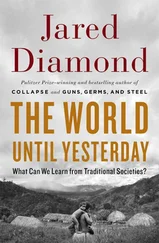Jared Diamond - Guns, Germs & Steel
Здесь есть возможность читать онлайн «Jared Diamond - Guns, Germs & Steel» весь текст электронной книги совершенно бесплатно (целиком полную версию без сокращений). В некоторых случаях можно слушать аудио, скачать через торрент в формате fb2 и присутствует краткое содержание. Жанр: 105. Описание произведения, (предисловие) а так же отзывы посетителей доступны на портале библиотеки ЛибКат.
- Название:Guns, Germs & Steel
- Автор:
- Жанр:
- Год:неизвестен
- ISBN:нет данных
- Рейтинг книги:5 / 5. Голосов: 1
-
Избранное:Добавить в избранное
- Отзывы:
-
Ваша оценка:
- 100
- 1
- 2
- 3
- 4
- 5
Guns, Germs & Steel: краткое содержание, описание и аннотация
Предлагаем к чтению аннотацию, описание, краткое содержание или предисловие (зависит от того, что написал сам автор книги «Guns, Germs & Steel»). Если вы не нашли необходимую информацию о книге — напишите в комментариях, мы постараемся отыскать её.
Guns, Germs & Steel — читать онлайн бесплатно полную книгу (весь текст) целиком
Ниже представлен текст книги, разбитый по страницам. Система сохранения места последней прочитанной страницы, позволяет с удобством читать онлайн бесплатно книгу «Guns, Germs & Steel», без необходимости каждый раз заново искать на чём Вы остановились. Поставьте закладку, и сможете в любой момент перейти на страницу, на которой закончили чтение.
Интервал:
Закладка:
SPACIOUS SKIES AND TILTED AXES • 187
Fertile Crescent livestock did. However, those tropical African crops could never be transmitted across South Africa's Fish River, beyond which they were stopped by Mediterranean conditions to which they were not adapted.
The result was the all-too-familiar course of the last two millennia of South African history. Some of South Africa's indigenous Khoisan peoples (otherwise known as Hottentots and Bushmen) acquired livestock but remained without agriculture. They became outnumbered and were replaced northeast of the Fish River by black African farmers, whose southward spread halted at that river. Only when European settlers arrived by sea in 1652, bringing with them their Fertile Crescent crop package, could agriculture thrive in South Africa's Mediterranean zone. The collisions of all those peoples produced the tragedies of modern South Africa: the quick decimation of the Khoisan by European germs and guns; a century of wars between Europeans and blacks; another century of racial oppression; and now, efforts by Europeans and blacks to seek a new mode of coexistence in the former Khoisan lands.
contrast also the ease of diffusion in Eurasia with its difficulties along the Americas' north-south axis. The distance between Mesoamerica and South America—say, between Mexico's highlands and Ecuador's—is only 1,200 miles, approximately the same as the distance in Eurasia separating the Balkans from Mesopotamia. The Balkans provided ideal growing conditions for most Mesopotamian crops and livestock, and received those domesticates as a package within 2,000 years of its assembly in the Fertile Crescent. That rapid spread preempted opportunities for domesticating those and related species in the Balkans. Highland Mexico and the Andes would similarly have been suitable for many of each other's crops and domestic animals. A few crops, notably Mexican corn, did indeed spread to the other region in the pre-Columbian era.
But other crops and domestic animals failed to spread between Mesoamerica and South America. The cool highlands of Mexico would have provided ideal conditions for raising llamas, guinea pigs, and potatoes, all domesticated in the cool highlands of the South American Andes. Yet the northward spread of those Andean specialties was stopped completely by the hot intervening lowlands of Central America. Five thousand years after lamas had been domesticated in the Andes, the Olmecs, Maya, Aztecs,
I 8 8 • GUNS, GERMS, AND STEEL
and all other native societies of Mexico remained without pack animals and without any edible domestic mammals except for dogs.
Conversely, domestic turkeys of Mexico and domestic sunflowers of the eastern United States might have thrived in the Andes, but their southward spread was stopped by the intervening tropical climates. The mere 700 miles of north-south distance prevented Mexican corn, squash, and beans from reaching the U.S. Southwest for several thousand years after their domestication in Mexico, and Mexican chili peppers and chenopods never did reach it in prehistoric times. For thousands of years after corn was domesticated in Mexico, it failed to spread northward into eastern North America, because of the cooler climates and shorter growing season prevailing there. At some time between a.d. 1 and a.d. 200, corn finally appeared in the eastern United States but only as a very minor crop. Not until around a.d. 900, after hardy varieties of corn adapted to northern climates had been developed, could corn-based agriculture contribute to the flowering of the most complex Native American society of North America, the Mississippian culture—a brief flowering ended by European-introduced germs arriving with and after Columbus.
Recall that most Fertile Crescent crops prove, upon genetic study, to derive from only a single domestication process, whose resulting crop spread so quickly that it preempted any other incipient domestications of the same or related species. In contrast, many apparently widespread Native American crops prove to consist of related species or even of genetically distinct varieties of the same species, independently domesticated in Mesoamerica, South America, and the eastern United States. Closely related species replace each other geographically among the amaranths, beans, chenopods, chili peppers, cottons, squashes, and tobaccos. Different varieties of the same species replace each other among the kidney beans, lima beans, the chili pepper Capsicum annuum I chinense, and the squash Cucurbita pepo. Those legacies of multiple independent domestications may provide further testimony to the slow diffusion of crops along the Americas' north-south axis.
Africa and the Americas are thus the two largest landmasses with a predominantly north-south axis and resulting slow diffusion. In certain other parts of the world, slow north-south diffusion was important on a smaller scale. These other examples include the snail's pace of crop exchange between Pakistan's Indus Valley and South India, the slow spread of South Chinese food production into Peninsular Malaysia, and
SPACIOUS SKIES AND TILTED AXES • 189
the failure of tropical Indonesian and New Guinean food production to arrive in prehistoric times in the modern farmlands of southwestern and southeastern Australia, respectively. Those two corners of Australia are now the continent's breadbaskets, but they lie more than 2,000 miles south of the equator. Farming there had to await the arrival from faraway Europe, on European ships, of crops adapted to Europe's cool climate and short growing season.
I have been dwelling on latitude, readily assessed by a glance at a map, because it is a major determinant of climate, growing conditions, and ease of spread of food production. However, latitude is of course not the only such determinant, and it is not always true that adjacent places at the same latitude have the same climate (though they do necessarily have the same day length). Topographic and ecological barriers, much more pronounced on some continents than on others, were locally important obstacles to diffusion.
For instance, crop diffusion between the U.S. Southeast and Southwest was very slow and selective although these two regions are at the same latitude. That's because much of the intervening area of Texas and the southern Great Plains was dry and unsuitable for agriculture. A corresponding example within Eurasia involved the eastern limit of Fertile Crescent crops, which spread rapidly westward to the Atlantic Ocean and eastward to the Indus Valley without encountering a major barrier. However, farther eastward in India the shift from predominantly winter rainfall to predominantly summer rainfall contributed to a much more delayed extension of agriculture, involving different crops and farming techniques, into the Ganges plain of northeastern India. Still farther east, temperate areas of China were isolated from western Eurasian areas with similar climates by the combination of the Central Asian desert, Tibetan plateau, and Himalayas. The initial development of food production in China was therefore independent of that at the same latitude in the Fertile Crescent, and gave rise to entirely different crops. However, even those barriers between China and western Eurasia were at least partly overcome during the second millennium b.c., when West Asian wheat, barley, and horses reached China.
By the same token, the potency of a 2,000-mile north-south shift as a barrier also varies with local conditions. Fertile Crescent food production
19o ' GUNS, GERMS, AND STEEL
spread southward over that distance to Ethiopia, and Bantu food production spread quickly from Africa's Great Lakes region south to Natal, because in both cases the intervening areas had similar rainfall regimes and were suitable for agriculture. In contrast, crop diffusion from Indonesia south to southwestern Australia was completely impossible, and diffusion over the much shorter distance from Mexico to the U.S. Southwest and Southeast was slow, because the intervening areas were deserts hostile to agriculture. The lack of a high-elevation plateau in Mesoamerica south of Guatemala, and Mesoamerica's extreme narrowness south of Mexico and especially in Panama, were at least as important as the latitudinal gradient in throttling crop and livestock exchanges between the highlands of Mexico and the Andes.
Continental differences in axis orientation affected the diffusion not only of food production but also of other technologies and inventions. For example, around 3,000 b.c. the invention of the wheel in or near Southwest Asia spread rapidly west and east across much of Eurasia within a few centuries, whereas the wheels invented independently in prehistoric Mexico never spread south to the Andes. Similarly, the principle of alphabetic writing, developed in the western part of the Fertile Crescent by 1500 b.c., spread west to Carthage and east to the Indian subcontinent within about a thousand years, but the Mesoamerican writing systems that flourished in prehistoric times for at least 2,000 years never reached the Andes.
Naturally, wheels and writing aren't directly linked to latitude and day length in the way crops are. Instead, the links are indirect, especially via food production systems and their consequences. The earliest wheels were parts of ox-drawn carts used to transport agricultural produce. Early writing was restricted to elites supported by food-producing peasants, and it served purposes of economically and socially complex food-producing societies (such as royal propaganda, goods inventories, and bureaucratic record keeping). In general, societies that engaged in intense exchanges of crops, livestock, and technologies related to food production were more likely to become involved in other exchanges as well.
America's patriotic song "America the Beautiful" invokes our spacious skies, our amber waves of grain, from sea to shining sea. Actually, that song reverses geographic realities. As in Africa, in the Americas the spread of native crops and domestic animals was slowed by constricted skies and environmental barriers. No waves of native grain ever stretched from the Atlantic to the Pacific coast of North America, from Canada to Patagonia,
Интервал:
Закладка:
Похожие книги на «Guns, Germs & Steel»
Представляем Вашему вниманию похожие книги на «Guns, Germs & Steel» списком для выбора. Мы отобрали схожую по названию и смыслу литературу в надежде предоставить читателям больше вариантов отыскать новые, интересные, ещё непрочитанные произведения.
Обсуждение, отзывы о книге «Guns, Germs & Steel» и просто собственные мнения читателей. Оставьте ваши комментарии, напишите, что Вы думаете о произведении, его смысле или главных героях. Укажите что конкретно понравилось, а что нет, и почему Вы так считаете.










